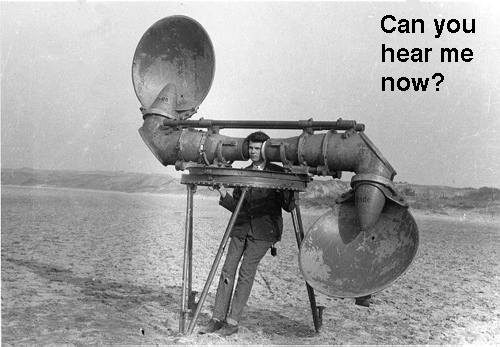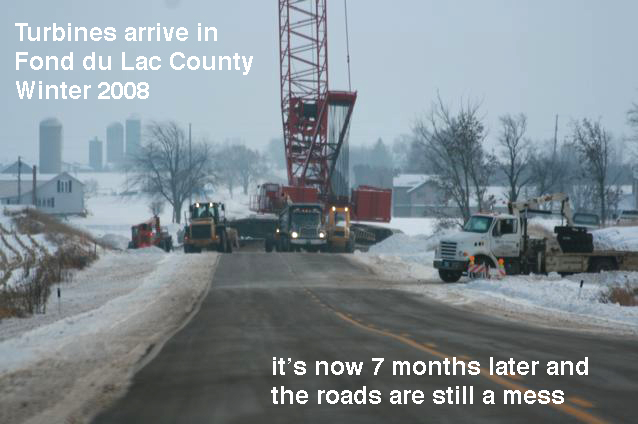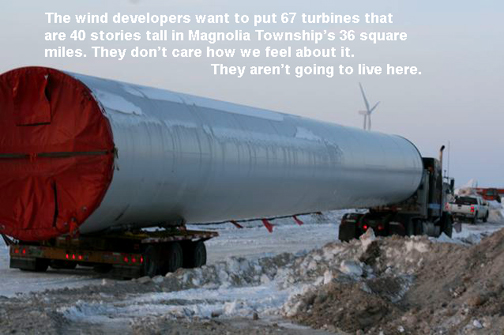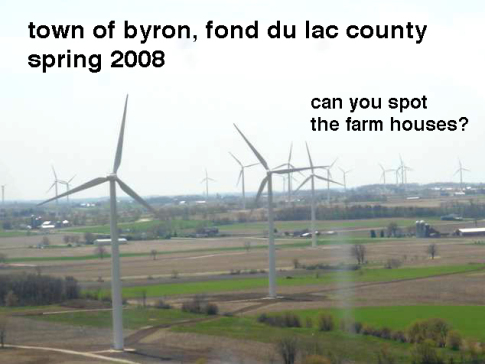7/7/08 Who Wrote The Fairy Tale of Wisconsin's 1000 Foot Set Back?
 When Wisconsin's town of Union made an open records request to find out what data was used to determine that 40 story moving machines with known noise issues could be built 1000 feet from our home as stated in the state's draft model ordinance (click here to download it) it was revealed that no scientific or medical data was used at all. So where did the 1000 foot setback come from? GO FISH! We can't answer that one either.
When Wisconsin's town of Union made an open records request to find out what data was used to determine that 40 story moving machines with known noise issues could be built 1000 feet from our home as stated in the state's draft model ordinance (click here to download it) it was revealed that no scientific or medical data was used at all. So where did the 1000 foot setback come from? GO FISH! We can't answer that one either.
But we can tell you that the people who make wind turbines disagree. The 2007 manual of Safety Regulations for Operators and Technicians for Vesta's Industrial Wind Turbines-- which are virtually virtually identical to the ones proposed for Magnolia and Union townships-- says that workers and operators should never go closer than 1300 feet from the turbine unless it is necessary. It says if you have to inspect a moving turbine, you should be in front of it, not under the blades:
It also says children must not be allowed to stay or play by the turbines. Why would they say this for any other reason than it's unsafe? So why does the state of Wisconsin say putting these turbines 1000 feet from our homes will not endanger our health and safety?
Why not contact the Public Service Commission and ask? (click here to visit their website)
ICE THROW: Read page 11 of 32 which of the manual reads "If the blades are iced up, it is highly dangerous to stay below or close to the rotor. If the turbine is to be restarted with iced- up blades, the operator must be very careful and make sure no persons are nearby because of the risk of falling ice"
We've been told by the wind developer who has targeted our area that 1000 feet is safe and there is no danger from ice throw. So where is he getting his information? Apparently it's not from the people who make the machines. Why are the people of Wisconsin asked to live a distance from wind turbines that even the a manufacturer says is unsafe?
7/6/08 Who set the noise standards in the draft model ordinance for wind turbines in the state of Wisconsin? What are they based on?
 An open records request from the town of Union's Large Wind Turbine Study Committee revealed that not a single bit of scientific or medical data was used in the Wisconsin's draft model wind ordinance to determine that a setback of 1000 feet from our homes is a safe distance for the siting of a 40 story tall wind turbine. What was used to determine the allowable noise levels these turbines can make? After all, noise is the issue. Two independent acoustic engineers weigh in with this letter sent to the Wisconsin Governor's Task force on Global Warming.
An open records request from the town of Union's Large Wind Turbine Study Committee revealed that not a single bit of scientific or medical data was used in the Wisconsin's draft model wind ordinance to determine that a setback of 1000 feet from our homes is a safe distance for the siting of a 40 story tall wind turbine. What was used to determine the allowable noise levels these turbines can make? After all, noise is the issue. Two independent acoustic engineers weigh in with this letter sent to the Wisconsin Governor's Task force on Global Warming.
Dear Sirs:
Please let me take this opportunity to briefly introduce ourselves. We are noise control consultants with many years of experience in community noise and related land-use planning issues. Mr. Kamperman has over 50 years of experience and was active in the early 1970's assisting the US EPA, states such as Illinois, and many communities in setting their community noise standards and guidelines. Mr. James has over 35 years of experience in the same field and has represented many of the largest corporations in the US on community noise issues and litigation. He has also served on the S12 Working Group for the American National Standards Institute, which has oversight on standards related to acoustics including community noise and works to coordinate ANSI standards with those of ISO and other standards organizations. We are currently involved with assisting some of the communities in Wisconsin with understanding and addressing wind turbine developments proposed for their communities.
We are writing this joint letter to the Task Force because we have mutual concerns about the impact of the work of the Task Force on the communities in Wisconsin that are under consideration for wind farm development. These concerns are a result of our work with those communities and our review of the Task Force's recent draft Policy documents and the Draft Model Wind Ordinance for Wisconsin (Feb. 7, 2007) and its associated reference guide.
Our review finds substantial errors of fact and understanding regarding community noise and the impact of noise on land-use planning and the safety and health of citizens that would be affected by these policies. We do not intend to address all of them but several of the more egregious errors are addressed in this letter.
It appears to us that there has been little or no input into the work of the Task Force from un-biased and experienced professionals from our profession. Nor does it appear that there has been much, if any input from the medical and research professionals. Mr. Kamperman suggests that one way to resolve this lack of expertise on the Task Force panel would be to include someone with his experience on the Task Force panel. Please consider the offer in the Post Script below.
We would like to address two major errors and failures of understanding in the Task Force's documents.
First, the limits and guidelines set forth fail to adequately consider the health and safety of the people who will be living in the communities in which the wind energy systems are to be located. For example, there is no scientific evidence currently available from independent medically qualified authorities to support a statement that the 50 dBA sound pressure level to which residents may be subjected on a 24/7/365 basis is safe and healthful for all people including children and those with special needs.
The World Health Organization has found[1] that sound levels during nighttime and late evening hours should be less than 30 dBA during sleeping periods to protect children's health. They noted that a child's autonomous nervous system is 10 to 15 dB more sensitive to noise than adults. Even for adults, health effects are first noted in some studies when the Lmax sound levels exceed 32 dBA, 10-20 dBA lower than the levels needed to cause awakening. The WHO researchers found that sound levels of 50 dBA or more strongly disrupted hormone secretion cycles. For sounds that contain a strong low frequency component, which is typical of wind turbines, WHO says that the limits may need to be even lower than 30 dBA to not put people at risk.[2] ANSI standards recommend that no sound pressure levels exceed 65 dB (e.g. No weighting) in the lower frequency ranges to avoid structural vibrations and potential damage. 50 dBA would not protect against this situation, yet studies have shown that wind turbine sounds at residences sometimes exceed 65 dB in the frequency range below 20 Hz.
The recent conference held in Lyons France for the purpose of addressing wind turbine noise and health concerns demonstrated that wind turbine sound emissions of the types routinely experienced by people living close to wind farms may have significant cardio-vascular health effects after long term exposure. Again, we caution the Task Force that there is no scientific or medical basis for equating a 50 dBA limit for Wisconsin communities with health and safety.
Both the policy statement and supporting Model Ordinance are woefully lacking any scientific evidence supporting the sound limits and other recommendations that impact the acoustical environment. There is no un-biased evidence presented that the people living near wind turbine installations will not be forced to accept industrial scale operations that could introduce new risks into a community against the will of its citizens. Further, the statements in these documents that 50 dBA is based on review of other statutes and standards adopted by communities with wind farms shows only that the other communities also did not properly research the issues of community noise and its effects on health and safety. There is no objective argument for considering these other standards as a reason to adopt a similar set of limits. The documents provided by the promoters of wind energy that support the methods and limits proposed by the Task Force that we have seen would not pass a peer review by professionals in our field. They, also, should not be used as the basis for guidelines in Wisconsin.
Second, to suggest the use of L10 as a descriptor of background sound levels is an egregious mistake. On what scientific basis has this recommendation been made? L10 is not a descriptor of background sound; L90 is the proper descriptor for background sound. L10 is a descriptor of noisiness from transient events. The wind turbines will produce steady sound emission for protracted periods of time. They should not be judged against transient events, but against the steady background sounds that occur during the periods of the day when quiet is expected.
Wind turbine siting guidelines for noise in Europe and many other parts of the world have adopted L90 to define the sound levels in communities prior to construction of wind farms. In New Zealand, L95 is used. The International Energy Agency (IEA) recommends the use of either L90 or L95 to define background sound levels.[3] L90 has been accepted and incorporated into documents developed by wind industry groups. For example, the British Wind Industry Association (BWEA) recommends that turbine sound levels should be kept to within 5 dBA of the average existing evening or nighttime background noise level and defines background noise level as the L90 sound level.[4]
It should be noted that even when these stricter guidelines are followed that experiences in Europe, Britain and New Zealand show that residents near the wind farms are often subjected to turbine noise that are considered objectionable.
Finally, if the mission of the task force is to enable the mission of the DNR:
- "To provide a healthy, sustainable environment and a full range of outdoor opportunities.
- "To ensure the right of all people to use and enjoy these resources in their work and leisure.
- "To work with people to understand each other's views and to carry out the public will."
Then, the views of the communities and citizens of Wisconsin who look to the State for guidance on what amounts to the industrialization of rural Wisconsin should be considered as positive and constructive efforts. Their concerns about noise and other new risks being introduced into their communities are valid. They should not be discredited by labeling their concerns as some form of NIMBYism or obstructionism as was implied in earlier drafts of the policy documents. Doing so devalues the input of Wisconsin's citizens to the State's efforts to promote renewable energy.
We appreciate the Task Force taking the time to consider our concerns and hope that they are taken in the most constructive light possible.
Sincerely,
George Kamperman, P.E.
Kamperman Associates, Inc.
312 Washington Avenue
Wisconsin Dells, WI 53965, USA
Telephone (608) 254-5656
george@kamperman.com
Richard R. James
E-Coustic Solutions
P.O. Box 1129
Okemos, MI 48805
Tel: (517) 507-5067
rickjames@e-coustic.com
P.S. from George Kamperman
I feel the wind turbine siting issues are so critical in many areas that I would welcome an opportunity to be a part of the PSC committee responsible for determining wind turbine siting guidelines for the State of Wisconsin. If the State is interested in my involvement in this endeavor I offer my services at no cost.
7/5/2008 Why do we need safe setbacks from industrial wind turbines?
 On July 3, Magnolia township adopted an ordinance which gives residents a safe setback from industrial wind turbines. Without this ordinance, developers would be able to put turbines 1000 feet from our homes. The ordinance requires a safer setback of 2640 feet. Many of us feel this is still not enough, but we are grateful for even this much protection, and we are grateful to all of the people who came to the hearing to testify in support of the ordinance.
On July 3, Magnolia township adopted an ordinance which gives residents a safe setback from industrial wind turbines. Without this ordinance, developers would be able to put turbines 1000 feet from our homes. The ordinance requires a safer setback of 2640 feet. Many of us feel this is still not enough, but we are grateful for even this much protection, and we are grateful to all of the people who came to the hearing to testify in support of the ordinance.
Most people don't yet understand how big these machines are and what sorts of problems they bring with them. The 67 industrial scale turbines proposed for Magnolia are 40 stories high with a blade span is wider than the wing span of a 747. The wind developer at Thursdays hearing said that even bigger ones were a possibility.
The proposal calls for the use of 7,000 to 8,000 acres of the township. That's 12.5 square miles or a third of Magnolia's 36 square miles. They won't be in one place, but scattered all over. This means that everyone in the township will be affected in one way or another.
Safe setbacks are needed for a number of reasons. At the hearing one of our residents gave testimony which names some of them. We're glad to be able to post this testimony and we thank the resident for taking the time to write it, come to the meeting and testify in support of the ordinance.
Testimony given July 3, 2008 at the Magnolia Wind Ordinance hearing:
First, I’d like to review the dangers to our health and safety from wind turbine machines.They catch fire, they throw ice, they explode and send blades and metal flying long distances, the cause problems to the electric system where power grids have shut down, and their noise is a hazard as well.
I have never seen any benefits to this community from this project that would offset endangering my health and safety, not to mention lowering my property values.
It’s a shame that we hear landowners say they don’t want the board (made up of fellow citizens) to tell them what to do with their land, but they are ready to hand over complete control of a part of their land to some company (possibly foreign) that they don’t know at all. It’s to bad we cannot make the point of how horribly this township-wide project will disrupt the natural beauty of Magnolia.
It’s to bad we cannot make the point of how horribly this township-wide project will disrupt the natural beauty of Magnolia.
I think it’s a shame that this will take so much away from our township and will give nothing, nothing in return.
Some of our citizens say that this ordinance is too restrictive with its setbacks. I say, if we are being restricted to discussing only health and safety issues with this ordinance, the I applaud the board members for using the extensive data from the Union Ordinance proposal, even if those setbacks might rule out this development. I want to thank the board for looking out for all the township residences, even if the citizens themselves are not aware of the many problems these giant turbines will cause.
This area of Rock County is too populated to handle so many of these gigantic machines. Magnolia should not sacrifice our quality of life for 30 years to this. Using words from one of our citizens, “It must be a good fit for our community.” This township-wide development is not!
My husband and I support this ordinance with at least ½ mile setbacks.
Thank- you.
Note from the Research Nerd: To see a video a turbine exploding and throwing blades and debris a great distance click here
To see a video of a wind turbine on fire, click here
To read about the problems with ice throw scroll down to our 4/29/08 post or find it by clicking here to visit Today's Special Feature Archives" list.
To watch a video of people living with the problems turbines cause in Wisconsin's Fond Du Lac county, click here.
7/3/2008 MAGNOLIA PASSES WIND ORDINANCE WITH HALF MILE SET BACK!
 Happy Independence Day!
Happy Independence Day!
Tonight, the Magnolia Town Board voted unanimously to pass the wind ordinance that includes a half mile set back and noise limits.
We want to thank everyone who attended tonight to give their testimony and support for this ordinance!
7/2/08 How can you turn just 90 minutes of your time on Thursday evening into something that saves our community from 30 years of industrialized misery?
 A special note from the BPRC Reseach Nerd:
A special note from the BPRC Reseach Nerd:
I’d like to invite people to attend a very important public hearing to be held on July 3, 7pm at the Magnolia Township hall regarding the large wind turbine ordinance. I’m hoping you will come to show your support for this well written ordinance which includes a 2640 foot setback from non-participating residences.
The reason for this set back has to do with noise and shadow flicker caused by these industrial machines. Noise is a real problem, especially at night. Several homes in Wisconsin’s Calumet county were made uninhabitable by noise from wind turbines and were purchased by the power company and bulldozed. (click here to read more about this)
Noise and shadow flicker have been problems for many people in Wisconsin’s Fond Du Lac county where wind turbines went on line in March of this year. (Click here to read more about this) Channel 6 news in Milwaukee did a story about it. (Click here to watch it) (Click here to request a free DVD copy of the news program) People from the town of Byron drove all the way to Evansville last month to testify at the Union township public hearing about how the problems with turbine noise and shadow flicker were affecting their lives. They were speaking from first hand experience and said they came because they didn’t want anyone else to have to live with what they were experiencing. (Click here to watch a video of their testimony) (and here)
The only thing that can reduce the trouble with noise and shadow flicker from a 40 story tall industrial machines is distance. The wind developers will make a fat profit if the setback is 1000 feet--- about 350 steps from your door. They will make less of a profit if it is anything more than that.
One of the developers is quoted a recent article as saying the setbacks recommended in the Union and Magnolia ordinances will make his project impossible. I’d like to point out this man said the same thing about Calumet County’s ordinance which has a 1800 foot setback. It seems that anything more than 1000 feet will make his project “impossible”. But what about those of us who will have to live next to these 40 story tall machines? What happens when it’s impossible to sleep, impossible to enjoy a quiet evening working in the yard, impossible to sell our house even if we wanted to because of the trouble that living beside industrial scale machinery always brings with it? The developer will be long gone then. At that point, only thing that will really be impossible is to understand how we could have let this happen to our community.
It reminds me a bit of the days when car manufacturers made a similar claims. That required safety equipment such as seat belts, safety glass, air bags, would make the manufacture of cars “impossible”. What they really meant is that huge profits would be made impossible by these safety requirements. Corporations have always fought for profit over human health and safety. It’s the nature of the beast. The wind developer is just doing is well-paid job.
I’d also like to point out that 67 wind turbines are proposed for the town of Magnolia’s 36 square miles. This means all of us will be affected in on way or another. With a 1000 foot set back, that number can grow quite easily. And there is no law saying other wind developers can’t come in and start making deals. What do you think will happen to our property values? Recent sworn testimony given by a real estate appraiser in Illinois revealed that while the normal market time for fairly priced homes located away from wind farms was 60 to 90 days, homes located near or within wind farms had market times of 200, 400 and over 800 days. (click here to download testimony or scroll down to the 6/30/08 entry)
Many homes could not be sold, and the ones that were sold were sold at a steep loss. It’s only common sense. If you had to choose between two similar homes, one near industrial wind turbines, and one that is not, which would you chose? The appraiser pointed out that what ever profits which come to those landowners who host wind turbines, come at the cost of lost property values for all those around him. How much does it cost to get a man to decide he should host a turbine? The numbers are confidential, but the wind developer has seemed to get people to agree to do this for anywhere from $4000 to $6000 a year. And the contract is for 30 to 40 years. No wonder there are so many who won’t sign.
Finally, though each 40 story turbine is rated at 1.5 megawatts, even the wind industry admits that at best they can only produce 30% of rated capacity in ideal conditions, and only when the wind is blowing. The wind in our area is less than ideal, and doesn’t always blow. There may be places where industrial turbines are a good reliable source of renewable energy, but Rock County doesn’t seem to one of them. If not for enormous government subsidies paid for with our tax dollars, the wind developers wouldn’t even be here.
There are great renewable energy options for our community but they will take the work of our citizens to get them in place. Manure digesters actually clean up the environment while they produce electricity. Biomass, solar, conservation and efficiency, all of these things will allow us to meet the states renewable energy goals without destroying our peaceful nights, ruining neighbor relations and lowering property values.
Unlike the wind developers we citizens are not paid fat salaries to do this, we don’t have paid out-of-town lobbyists like the ones who show up at our township meetings to try to sway our town boards, we can’t sponsor bus trips or free pizza dinners or open houses with slick displays. We can’t offer signing bonuses. And we’re not eligible for the big government subsidies that the wind industry admits they could not survive without. But we can make it happen. And we will make it happen.
I urge everyone to take 90 minutes of time on July 3, at 7pm, to come to the Magnolia Township Hall (County Road A, West of 213) to attend the public hearing in support of the ordinance which will give us a safe setback. Just 90 minutes of your time could help save our community from 30 years of industrialized misery. Please come and support this ordinance.